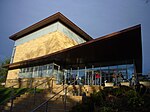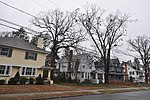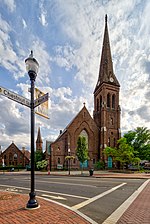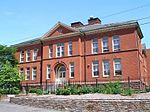Sloper-Wesoly House
Buildings and structures in New Britain, ConnecticutHouses completed in 1887Houses on the National Register of Historic Places in ConnecticutNational Register of Historic Places in Hartford County, ConnecticutQueen Anne architecture in Connecticut

The Sloper-Wesoly House is a historic house at 27 Grove Hill Street in New Britain, Connecticut. Built in 1887, it is a prominent local example of Queen Anne architecture in brick, and a long-standing site of importance to the city's Polish community. It was listed on the National Register of Historic Places in 1999. It now houses a local Polish cultural center.
Excerpt from the Wikipedia article Sloper-Wesoly House (License: CC BY-SA 3.0, Authors, Images).Sloper-Wesoly House
Tadeusz Kosciuszko Highway, New Britain Little Poland
Geographical coordinates (GPS) Address Nearby Places Show on map
Geographical coordinates (GPS)
| Latitude | Longitude |
|---|---|
| N 41.666666666667 ° | E -72.791666666667 ° |
Address
Tadeusz Kosciuszko Highway
06052 New Britain, Little Poland
Connecticut, United States
Open on Google Maps











